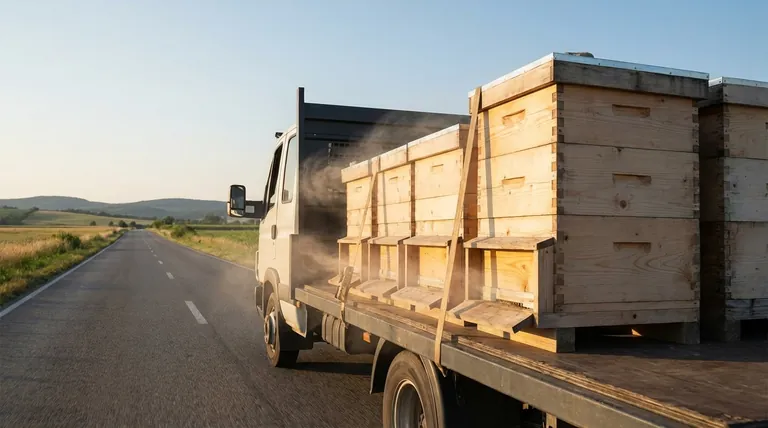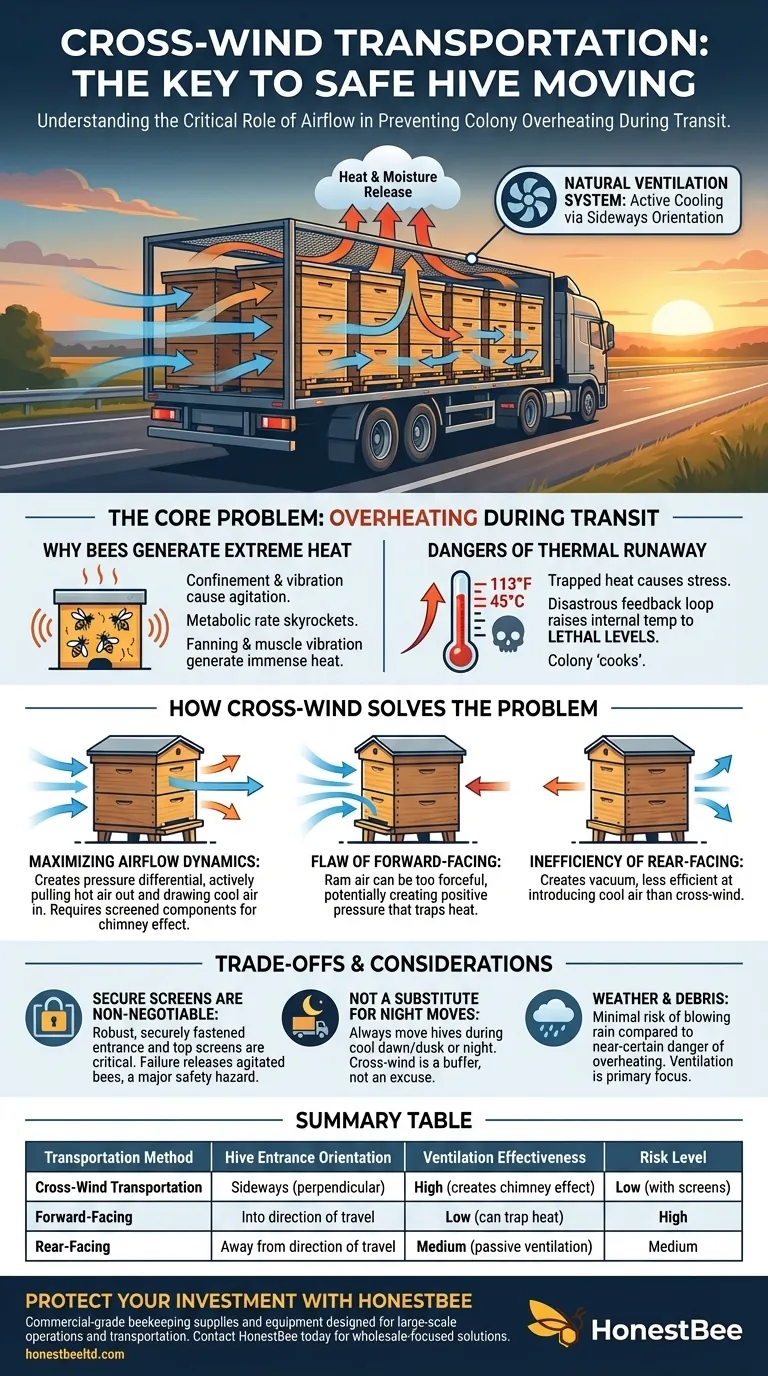When moving beehives, the single most critical factor for colony survival is temperature regulation. Cross-wind transportation is the practice of orienting the hive on a truck or trailer so the entrance faces sideways, perpendicular to the direction of travel. This simple alignment allows air to flow across the entrance, creating a natural ventilation system that pulls hot, humid air out of the hive and prevents the colony from fatally overheating during the stress of transit.
Moving a sealed beehive creates a high-risk environment where agitated bees can generate lethal amounts of heat. Cross-wind transportation is not merely a helpful tip; it is a fundamental safety protocol that leverages natural airflow to actively cool the hive and ensure the colony's survival.

The Core Problem: Overheating During Transit
Understanding why hives are so susceptible to overheating is the first step in appreciating the solution. The risk is a direct result of bee biology and the physics of a confined space.
Why Confined Bees Generate Extreme Heat
When sealed for transport, bees sense the confinement and vibration, causing widespread agitation. In this state, their metabolic rate skyrockets. They begin fanning their wings and vibrating their flight muscles, which collectively generates an immense amount of heat within the hive.
The Dangers of Thermal Runaway
Without adequate ventilation, this heat becomes trapped. As the temperature rises, the bees become more stressed, increasing their metabolic activity further in a disastrous feedback loop. This process, known as thermal runaway, can raise the internal hive temperature to lethal levels (above 113°F or 45°C) in a surprisingly short amount of time, literally "cooking" the colony.
The Compounding Effect of Stress
The constant vibration and jostling of the vehicle add significant stress, ensuring the bees remain agitated for the entire journey. This makes active cooling not just a benefit, but a necessity for any move that isn't just a few minutes long.
How Cross-Wind Transportation Solves the Problem
The orientation of the hive entrance relative to airflow dictates the effectiveness of ventilation. The cross-wind method is superior because it is based on sound aerodynamic principles.
Maximizing Airflow Dynamics
Placing the entrance sideways to the direction of travel allows air to move across the opening. This creates a pressure differential that actively pulls stale, hot, and moisture-laden air out of the hive while allowing fresh, cooler air to be drawn in. It establishes a consistent, life-saving air exchange.
The Flaw of a Forward-Facing Entrance
Orienting the entrance to face forward seems intuitive, but it can be counterproductive. Air rams directly into the entrance, which can be too forceful for the bees clustered near the opening. More importantly, this can create positive pressure that impedes hot air from escaping from other parts of the hive, like a screened top.
The Inefficiency of a Rear-Facing Entrance
A rear-facing entrance is safer than a forward-facing one but is less effective than the cross-wind method. It creates a vacuum effect that can help pull air out, but it is less efficient at actively introducing cool air into the hive stack.
The Importance of Screened Components
Cross-wind transportation is most effective when used with a screened bottom board and/or a screened inner or top cover. This creates a clear "chimney effect," allowing air to enter the side entrance, flow up through the hive bodies, and exit through the top, ensuring the entire colony benefits from the cooling airflow.
Understanding the Trade-offs and Considerations
While highly effective, this technique must be implemented correctly and is not a cure-all for poor transportation practices.
Secure Screens are Non-Negotiable
The primary risk is screen failure. Whether it's an entrance screen or a top screen, it must be robust and securely fastened. A failure at highway speeds will release thousands of agitated bees, creating a significant public safety hazard and resulting in major colony loss.
Not a Substitute for Night Moves
This technique is a safety measure, not a license to ignore best practices. Hives should always be moved at night or during very cool dawn/dusk hours when the bees are naturally clustered and less active. Cross-wind orientation provides a critical buffer against unexpected delays or temperature changes.
Weather and Debris
A sideways orientation could allow blowing rain to enter the hive more easily than a rear-facing setup. However, this risk is minimal compared to the near-certain danger of overheating. The primary focus must remain on ventilation.
Making the Right Choice for Your Goal
Your transportation strategy should be directly informed by your primary objective: protecting your bees.
- If your primary focus is colony survival on moves over 30 minutes: Always use cross-wind orientation combined with a screened top cover. This is the gold standard for ensuring adequate ventilation and preventing catastrophic heat buildup.
- If your primary focus is a very short move in cool weather: While cross-wind is still best practice, the risk is lower. At a minimum, ensure you have a screened top for passive ventilation.
- If your primary focus is using an enclosed, climate-controlled truck: The hive orientation is irrelevant, but you must have absolute confidence in your vehicle's cooling system and its redundancies.
Proper hive orientation is a simple, no-cost insurance policy that protects your most valuable asset.
Summary Table:
| Transportation Method | Hive Entrance Orientation | Ventilation Effectiveness | Risk Level |
|---|---|---|---|
| Cross-Wind Transportation | Sideways (perpendicular) | High (creates chimney effect) | Low (with screens) |
| Forward-Facing | Into direction of travel | Low (can trap heat) | High |
| Rear-Facing | Away from direction of travel | Medium (passive ventilation) | Medium |
Protect Your Investment with Professional-Grade Equipment
As a commercial beekeeper or distributor, every hive loss impacts your bottom line. HONESTBEE supplies durable, commercial-grade beekeeping supplies and equipment designed specifically for the rigors of large-scale operations and transportation.
We understand that proper hive orientation is just one part of successful apiary management. Our screened bottom boards, secure inner covers, and transportation equipment are built to withstand highway speeds and protect your colonies during transit.
Ready to optimize your beekeeping operations with wholesale-focused solutions? Contact HONESTBEE today to discuss how our equipment can help you implement cross-wind transportation safely and efficiently across your entire operation.
Visual Guide

Related Products
- Wholesales Dadant Size Wooden Bee Hives for Beekeeping
- Versatile Ratchet Hive Strap with S-Hooks for Secure Fastening
- Professional Grade Foldable Beehive Handles
- HONESTBEE Classic Pry Bar Hive Tool with High Visibility Finish for Beekeeping
- Professional Galvanized Hive Strap with Secure Locking Buckle for Beekeeping
People Also Ask
- What is beekeeping equipment? Essential Tools for Commercial Apiaries & Distributors
- What are the advantages of wooden bee hives? Superior Bee Health & Beekeeper Flexibility
- What should beginners consider when purchasing beekeeping equipment? A Guide to Essential Starter Gear
- What are the characteristics of oil-based paint for beehives? Durability vs. Modern Practicality
- What is the best place to keep bees? Find the Perfect Apiary Site for Your Hives



















